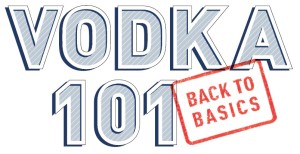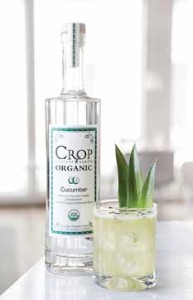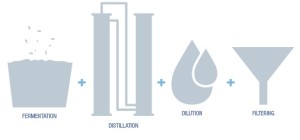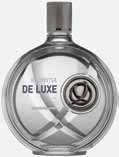
By Jeff Cioletti
 Vodka may have emerged from Eastern European distilling and drinking cultures, but as far as spirits are concerned, it’s probably the closest to the Wild West anyone’s going to get. That’s because there’s no clear standard mandating from which starchy or sugary bases it must be fermented. That’s not to say there aren’t some standards in place. The European Union, for instance, sets the vodka ABV minimum at 37.5% (75 proof). On these shores, the TTB sets the ABV Vodka may have emerged from Eastern European distilling and drinking cultures, but as far as spirits are concerned, it’s probably the closest to the Wild West anyone’s going to get.
Vodka may have emerged from Eastern European distilling and drinking cultures, but as far as spirits are concerned, it’s probably the closest to the Wild West anyone’s going to get. That’s because there’s no clear standard mandating from which starchy or sugary bases it must be fermented. That’s not to say there aren’t some standards in place. The European Union, for instance, sets the vodka ABV minimum at 37.5% (75 proof). On these shores, the TTB sets the ABV Vodka may have emerged from Eastern European distilling and drinking cultures, but as far as spirits are concerned, it’s probably the closest to the Wild West anyone’s going to get.
That’s because there’s no clear standard mandating from which starchy or sugary bases it must be fermented. That’s not to say there aren’t some standards in place. The European Union, for instance, sets the vodka ABV minimum at 37.5% (75 proof). On these shores, the TTB sets the ABV floor at 40% (80 proof). The U.S. regulatory agency defines the spirit as “neutral spirits distilled or treated after distillation with charcoal or other materials so as to be without distinctive character, aroma, taste or color.”
However, vodka’s complete lack of all of those things makes it the nearly perfect blank canvas on which mixologists can paint their masterpieces. Ask a group of cocktail crafters and enthusiasts, “What’s the most mixable spirit?” and at least nine out of 10 of them will likely answer, “Vodka.”
Where Is It produced?
Anywhere. There are no official region-of-origin protections for vodka (despite the best efforts of many former Eastern Bloc countries). Technically, a distiller in any part of the world can distill a spirit from just about any fermentable base and call it vodka. Despite that, it’s still very closely associated with countries in the “Vodka Belt”—especially Russia and other former members of the Soviet Union, as well as Poland and Nordic countries like Sweden and Finland. The rise of craft distilling in the U.S. has created a wave of new American interpretations of the spirit.
Did You Know?
The word “vodka” derives from the word for “water” in many Slavic languages,voda. Adding “ka” to a Russian name makes it the diminutive form, as a form of familiarity and affection. So “vodka” is, essentially, but not directly, “little water” or “my dear water.”
What’s it made from?
An easier question to answer would be, “What’s it not made from?” If it’s got fermentable sugars, it’s pretty much fair game. However, the two classic bases are:
- Grains—wheat most commonly, but other cereals like rye and corn often find their way into the mash.
- Potatoes are another popular base.
Distillers have also made vodka from beets, grapes, molasses, milk, apples, even hops.
FEATURED BRAND: Crop Vodka
 When making vodka, there is nowhere for the distiller to hide. With the goal of stripping away all extraneous flavor—and no barrel-aging to fall back on for development—the spirit’s purity is paramount. While some producers downplay the material used for pre-distillation mash, others consider it critical.
When making vodka, there is nowhere for the distiller to hide. With the goal of stripping away all extraneous flavor—and no barrel-aging to fall back on for development—the spirit’s purity is paramount. While some producers downplay the material used for pre-distillation mash, others consider it critical.
For Crop Harvest Earth Vodka, the base is USDA certified organic grain, harvested from fertile soil free of artificial fertilizers, pesticides and chemicals. The purity of the mash sets the foundation for a pristine final spirit, which is also used for flavored expressions, infused with all natural Cucumber, Tomato or Meyer Lemon.
All Crop vodkas benefit from hands-on, small batch production:
- Each batch of Crop is distilled only the exact number of times necessary to remove specific impurities and their unwanted flavors from that particular batch.
- Crop is distilled so efficiently that no carbon treatment or charcoal filtering is required.
- The end result is a refreshingly crisp, clean, pure vodka.
Crop Vodka Cocktail Recipe: Babylon Express
- 2 parts Crop Organic Cucumber Vodka
- 1 part Elderflower Liqueur
- 1 part Pineapple Juice
- ¾ part Lime Juice
Combine with ice in shaker; pour into rocks glass. Garnish with pineapple fronds.
How is it made?
 Production is deceptively crucial in vodka, as the name of the game is purity—whatever bells and whistles are employed lean toward stripping away flavor.
Production is deceptively crucial in vodka, as the name of the game is purity—whatever bells and whistles are employed lean toward stripping away flavor.
- Distillers create a mash from the malted grain, potato or other fruit or vegetable source.
- Once the fermentation process ends, it’s distilled multiple times, typically through column distillation. The continuous distillation process removes impurities and results in a spirit that’s at least 190 proof. A spirit that’s upwards of 95% alcohol is more pure grain alcohol than vodka and barely drinkable.
- What goes up in proof must come down; vodka is bottled between 80 and 110 proof, so every vodka is diluted. A typical 80 proof vodka contains 60% water, and there is no adding of botanicals or barrel treatment post-dilution, so that water is critical.
- Distillers then filter it through charcoal multiple times. (Marketers are apt to tout a very high number of passes, and/or alternate filtering material, for what they say is optimal purity.) After that, they add a little more water to bring it to its desired ABV of around 40% (80 proof).
Note: Charcoal—or, more accurately, activated carbon—remains a popular vodka filtering agent, but brands have also touted sand, diamonds, paper, bamboo, cellulose, rock and precious metals as points of filtering/marketing distinction.
Common uses:
It’s hard to know where to begin because it’s probably the most common cocktail base there is. But here are a few:
Blood Mary: It wouldn’t be brunch without a good Bloody; and many a Bloody has been batched using the most basic of vodkas.
Vodka + Juice: The Screwdriver (with OJ), The Greyhound (grapefruit) and the Seabreeze (grapefruit and cranberry) are benchmarks; their easy-drinking popularity helped fruit-flavored vodkas make sense.
Vodka Martini: Many purists insist that gin is the only spirit for a Martini, but vodka is just as popular. (Doesn’t hurt that 007 typically orders his with vodka and “shaken, not stirred”—giving rise to another catchphrase that makes Martini fans cringe.) In its most basic form, the Vodka Martini is vodka and vermouth (typically dry), chilled with ice and then strained into a stemmed martini glass and garnished with olives.
Moscow Mule: Ginger beer (not ginger ale, mind you) and lime juice has both stood the test of time and inspired spin-offs; properly served in a rounded copper mug.
White Russian: Jeff “The Dude” Lebowski’s favorite drink, the White Russian usually consists of vodka, coffee liqueur (Kahlua is most common) and cream (occasionally milk).
Harvey Wallbanger: Granted, the raison d’être of a Harvey Wallbanger is Galliano, but there is actually more vodka than liqueur in there. A hit in the ’70s, this drink was born in the 1950s, supposedly named after a surfer.
What are the latest vodka trends?
- It’s less about fancy, VIP bottle service with super-premium badge brands and more about quality ingredients and transparent, authentic provenance and processes, especially as consumers are more educated about where, how and with what their beverages are made.
- Thanks to the product’s natural neutrality, points of distinction often center on production methods, water sources and filtration. Predictably, the more expensive the vodka, the more specific and fine-tuned these elements become.
- Similarly, packaging has become a focal point among marketers, especially at higher price points.
Important Dates In Vodka History
- 1782: The first industrial distillery is opened in Poland, in Kresy, the eastern part of the country, controlled by the Russian empire. It is also around this time that producers begin making vodka from various unusual substances besides grain and potatoes.
- 1917: Commercial vodka is brought to America by émigré Rudolph Kunnetchansky, who fled the Russian Revolution.
- 1960s: Vodka sales soar as a new generation of Americans discovers cocktails like the Moscow Mule andbegin mixing vodka with fruit juices and tonic.
-
1975: Vodka becomes the bestselling spirit in the U.S., with about 32 million cases sold (less than 2% imported).
-
2007: In 2007 a group of countries including Poland, Sweden and Lithuania tries to get the EU’s definition of vodka changed to exclude any products not made from potatoes or grains. While the effort fails, the regulatory body amends EU law to stipulate that any vodka not derived from spuds or grains must include what it is distilled from on its label, if it is to be sold in the EU.
FEATURED BRAND: Leaf Vodka
Water: The Difference-Maker. By law, all vodka must be diluted. After it has been brought down from its peak of at least 190 proof (95% ABV) during distillation to 80 proof (40% ABV) for bottling, the final product is effectively 60% water. It follows that a brand’s water source is critical to its character. Leaf Vodka is one notable supplier that not only stresses the importance of water, but proves its impact with a pair of flagship products made exactly the same way except for different water sources: one in Alaska, one in Colorado.
- Leaf Vodka made from Alaskan Glacial Water uses as its source Blue Lake, which is fed by four separate glaciers, imparting a pure, smooth taste.
- Leaf Vodka made from Rocky Mountain Mineral Water gains an unusual richness and complexity.
- Both 5 times distilled and USDA Certified Organic
The distinctions are subtle, but to vodka lovers they are quite real, and for mixologists, experimenting with both can reveal pronounced distinctions in cocktails.
Leaf Vodka Cocktail Recipe:
Peaked Leaf:
- 2 oz. Leaf Vodka made from Rocky Mountain Mineral Water
- Grapefruit Juice
- 1 Lime Wedge
Fill highball glass with ice, and add vodka. Fill the rest of the glass with grapefruit juice to just below the rim. Garnish with lime.
Gold Leaf:
- 2 oz. Leaf Vodka made from Alaskan Glacial Water
- Orange Juice
- Splash of Ginger Ale
- 1 Orange Wedge
Fill highball glass with ice, and add vodka. Fill the rest of the glass with orange juice to just below the rim. Top off with ginger ale. Garnish with orange.
Vodka By The Numbers:
Vodka Remains the top dog, commanding 32% of share of spirits consumption in the United States in 2015. The category has declined slightly over the past few years, but still leads whiskey by more than 11 Million cases. The decline in vodka is in the flavored sector, more than neutral. And, flavored vodka sales were down -5.9% in 2015 (SOURCE: 2016 IWSR U.S. Beverage Alcohol Review).
Selling Points:
- As the most mixable spirit, it will never go out of style
- Every home bar needs vodka – at least one. That’s also why vodka makes a great gift.
- Because vodka is essentially neutral, buying by the label is as risk-free as any spirits category gets.
- Craft spirit produces have brought an artisanal edge to a spirit that was once in danger of being commoditized. Consumers are paying a premium for vodkas they perceive as hand-crafted with a good story behind them.
FEATURED BRAND: Khortytsa
 Authentic Ukraine. Much is made of vodka’s deep roots in Eastern Europe. In an interesting twist, Khortytsa is making the most of both Ukraine’s authentic distilling legacy and state-of-the art technology.
Authentic Ukraine. Much is made of vodka’s deep roots in Eastern Europe. In an interesting twist, Khortytsa is making the most of both Ukraine’s authentic distilling legacy and state-of-the art technology.
- Distilled in Ukraine using modern techniques amid a culture with centuries of vodka expertise.
- The Khortytsa (Hor-Ti-Tsa) distillery was built from the ground up and named after the island of Khortytsa, Ukraine’s natural and historical marvel.
- Water passes through silver, platinum and carbon filtration for ideal transparency, stability and taste; the De Luxe goes through an additional quartz filter.
- Third largest global vodka brand; named one the world’s best distilleries at the 2014 New York International Spirits Competition.
As is the case with many vodka producers, Khortytsa makes a range of expressions:
Khortytsa De Luxe represents the perfect combination of natural ingredients and the purest water; exquisite flavor and soft texture.
Khortytsa Platinum has excelled at the Ultimate Spirits Challenge for the past two years; 2015 judges called it “a winner on all levels.” Delicate and balanced, it is perfect for cocktails.
Khortytsa Ice is a game-changer: infused with mint, lime and menthol, it delivers exotic flavor and a feeling of coolness; plus the Ice bottle changes from frosted white to deep blue when the vodka is perfectly chilled.
Khortytsa Pepper Honey Hot pairs the piquancy of red peppers with sweet honey, and is Ukraine’s first vodka with peppercorns in the bottle.
Download the full Vodka 101 pdf here.
See Flavored Vodka 101 here.



